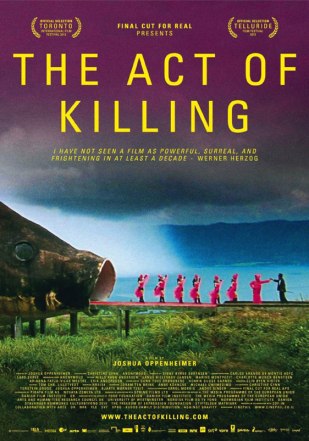I attempted to write about this film at an angle that discusses it in detail, but I felt that it is something to be left to the viewers. Joshua Oppenheimer’s The Act of Killing can be summarized in one word: terrifying. The idea that a man can proclaim that he killed thousands of men with utmost conviction and mirth cannot be put into words; seeing murderers re-enact their war crimes and create a film based on them is indigestible.
The Act of Killing revolves around the genocide that happened in the 1960’s, when the Pancasila Youth rose into power after the overthrow of Sukarno. Anwar Congo, the main focus of the film, is the leader of one of the most notorious gangster squads in the Medan area and was responsible for killing 1000 men between 1965 and 1966.
Since these ex-killers wanted their story to be known, Oppenheimer approached them by asking the killers to write, produce, and star in their own film. This concept got me intrigued, as I believe that there is no documentary that has done this setup. Even harder to believe is that you’re asking ex-killers to portray their atrocities in such a creative platform, where you have musical numbers, Hollywood references and much, much more injected to the film.
As the ex-killers were developing their plot, they recount the violence they’ve done in the past with such objectivity, as if talking about the murders is integrated into their daily musings. The killers are very much aware that their actions are wrong however. “We were allowed to do it and we were never punished,” said Adi Zukaldry. Congo was determined to make the re-enactment as accurate as possible, recounting various methods of torture and execution such as strangulation using wires, stepping on their prisoners’ throats using table legs, and plain beatdown. One killer even expresses that he found joy in raping beautiful girls. He remarks, “it’s going to be hell on Earth for them but heaven on Earth for me.”
The Act of Killing continued its examination of human morality by depicting a scene in the film, wherein Anwar’s decapitated head was beside his rotting corpse. Beside him was his conscience, played by his brethren Herman Koto, who then proceeded to eat Anwar’s liver and penis in front of him. When the two watched the scene, Anwar argued that it should be put at the beginning of the scene so that it wouldn’t mislead the viewers into thinking that what has happened to him was karma. He wanted to be seen as someone who was oppressed by the communist by mutilating his body but rose to exact revenge for himself and for the people that the communists ‘hurt.’ The whole sequence says a lot as to how we justify our act so that we can look heroic even though it’s clear that what we’re doing is wrong.
As the film further unfolds, we see Congo strapped to a chair and being interrogated: he’s assuming the role of a communist. He was then tortured using his own method, the wire strangulation. His life flashes right before his eyes at that moment. The scene goes into a cut, and he exclaims that he can’t do the scene again. This is the first time I saw Anwar Congo scared, trembling into the idea of being victimized by the very same thing that he has done to thousands of innocent lives he took. He was proud to show the take to his grandsons at his home, but when they were gone, he starts bursting into tears, guilt-laden and full of regret. His monstrosity had already caught up with him.
In the last scenes of the film, Congo returned to the rooftop of the Medan Pos. This time, there’s no laughter and no dancing — as he was on the opening scene of the film — only lament and realization that he was a cog in the wheel in the darkest times of Indonesia.
No killers were convicted and tried. They are still their own villages, wearing fancy clothes, drinking and dancing every night, and leading such happy lives with their families. The Pancasila Youth is three million strong today, with the heads of the country protecting the gangsters or ‘free men’ as they refer to themselves. Today, they carry out jobs that are too nefarious for the government to handle, such as illegal gambling, smuggling, extortion, bribery, and of course, murder.
Despite this horrible truth, I believe the intent of the film is to uncover what man can do when he’s given power and is allowed to play god. It has little to do with the history of the Pancasila Youth, the genocide of 1965 – 1966, and the life of Anwar Congo and his gangster squad. The Act of Killing truly deserves the recognition and high acclaim it has garnered, as it shows the barbaric nature of man while combining fact and fiction into a seamless storyline. This movie will challenge and astonish you; definitely a must-watch!
